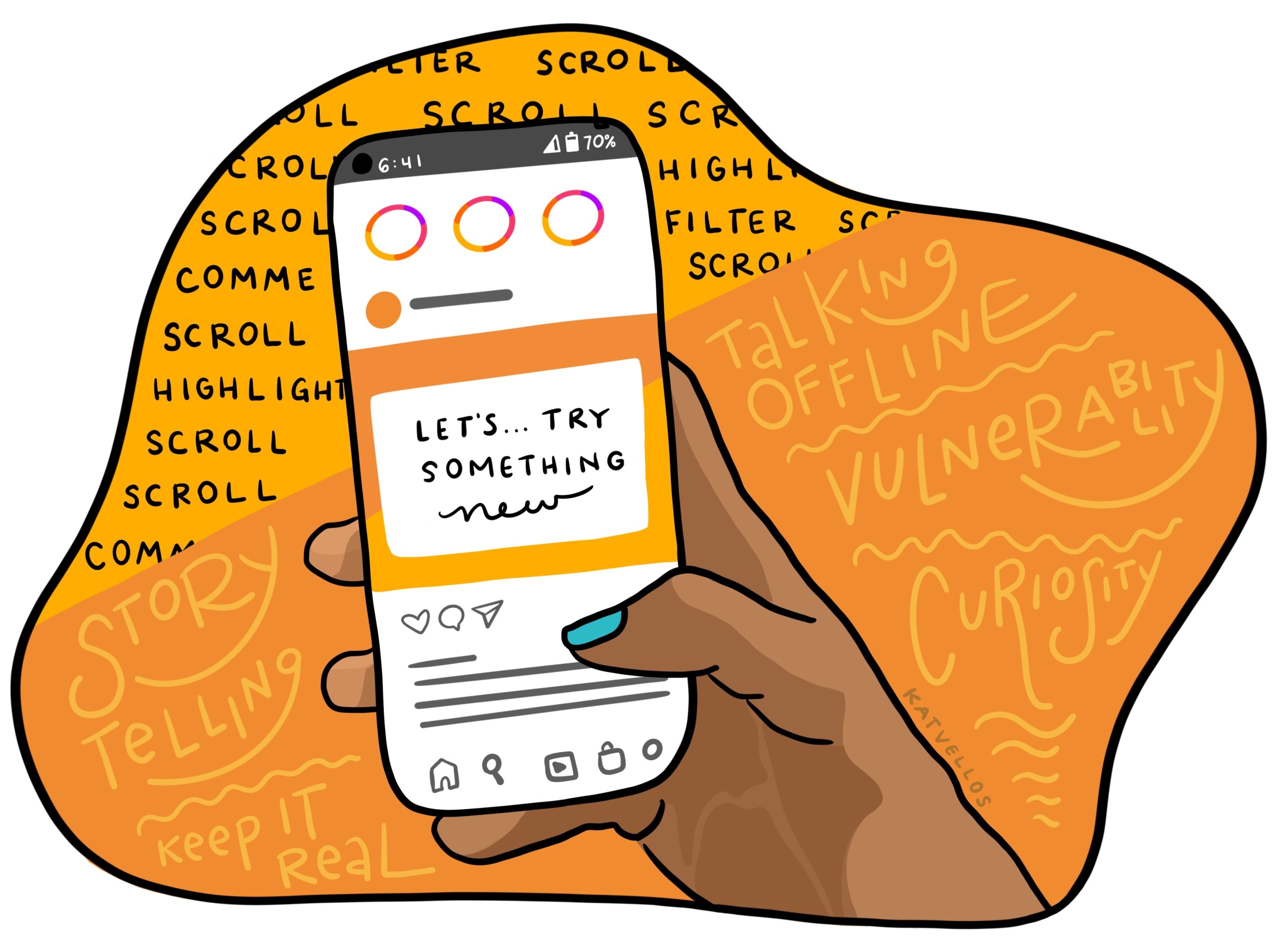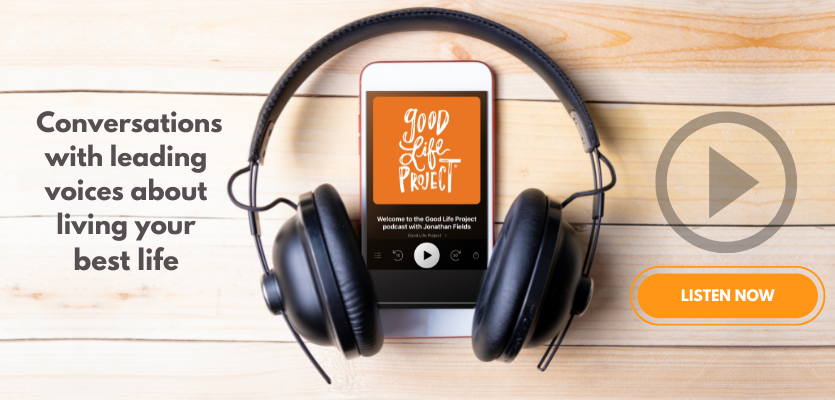As humans, we’re biologically wired to connect. So how is it that in a time when we have technology all around us that should play right into this biological need – we’re actually feeling more disconnected than ever?
A 2021 survey of 1,250 U.S. adults revealed that 58% of Americans believe social media negatively impacts their mental health, citing anxiety, depression, and isolation as common side effects. And of course, you’ve felt it too. Whether it’s that wave of FOMO you get looking at a friend’s feed, the craving to go beyond the surface level interactions the algorithm favors, or the inherently asynchronous nature of social media that tends to strip the honesty and vulnerability of real-life interactions, social media can be, let’s face it, pretty anti-social.
Even aside from that, people seem to be feeling more disconnected in general. Friendship researcher and GLP podcast guest Kat Vellos talks about what she calls an uptick in Platonic longing, where she would talk to people who had close connections in their life –– their spouse, a roommate, etc, but still felt unfulfilled.
“What they were craving was a really intimate friendship. Feeling safe, feeling heard, and seen feeling comfortable sharing anything, whether it’s a happy day or an angry day, and knowing that they would be accepted and still loved and held by that friend. They wanted to feel cared about in a time of need, like this was a very, very specific ache.”
But it doesn’t have to be this way. Turns out, there’s a whole lotta things you can do to make real, authentic connections, even in our increasingly digitized world –– here are five of our favorites.
1. Understand “the friendship formula” and bids.
Nobody really ever teaches us how to make friends — especially as an adult. So it’s no wonder a lot of people have difficulty deepening their connections. The good news is that making friends isn’t some completely mysterious thing that either happens or doesn’t, or that you naturally know how to do, or don’t. While there’s definitely elements of serendipity in friendship, it turns out that there’s more concrete and replicable elements too.
Dr. Jack Schafer, retired FBI agent and expert on human interactions, even says there’s a formula. According to Schafer, the friendship formula is:
Friendship = proximity + frequency + duration + intensity.
(If the math thing is throwing you, just think of those four things as the four building blocks of friendship.)
Each one of these elements is crucial for connection, because if you lose one, the other three lose a lot of their power. For instance, you might spend a lot of time with your spouse (proximity + frequency + duration) but if you’re both spending all that time on your phones ignoring each other, the relationship will likely suffer — the intensity factor is lacking.
The cool thing is, this formula works long-distance too. While the proximity factor will be more community-based instead of based on physical proximity, spending time with the same people over and over, even in the virtual space, can have similar effects.
 Art by Kat Vellos
Art by Kat Vellos
2. Disconnect to reconnect
Relationships form and deepen with focus and awareness … two things that technology can really interfere with. If you’ve been really down the tech rabbit hole for a while, it might be time to take a small break so you can reconnect with your relationships.
You don’t have to do this forever (of course), and you don’t even have to do it in every area of your life. In fact, if you make just your bedroom and your mealtimes tech-free zones, you can see some really powerful effects.
Why these two particular places? Because research shows that they’re two of the most important opportunities for topping up your connection.
The ritual of mealtime is a wonderful opportunity for deepening relationships (talk about an opportunity for proximity + frequency + duration!), but it’s changed dramatically over the past 100 years or so, in some places disappearing almost entirely.
From a survey of over 1,000 US adults:
“Eating at the dinner table is becoming obsolete. While 72% of respondents said they grew up eating at the dining room table, only 48% do so today. Additionally, the couch has nearly tripled as the primary eating place (from 12% to 30%), along with the bedroom (6% to 17%).” (The Atlantic)
And of course the bedroom is meant to be your sanctuary from the world, the place you go to restore and reconnect with yourself, and with your partner. But putting a cellphone in the mix can mess with everything from your sleep schedule:
“Growing evidence suggests that [electronic technologies] take their toll on human functioning and health via their damaging effects on sleep quality, quantity and timing.” (National Library of Medicine)
…. to your sex life.
“Thirty-five percent [of adults in a 2000 person study] say their sex life has been impacted because of their or their spouse’s bedtime phone use.” (Asurion).
And it can have lasting effects on your stress levels and happiness:
“Prospective associations were found between ICT [aka cellphone] use at baseline and stress, sleep disturbances, and symptoms of depression at 1 year follow-up.”
The good news is, even taking short breaks from your tech can have a big impact –– a 2020 study found that people can see positive effects from a digital detox in just seven days.
3. Show up
There’s no way around it: if you want to get to know other people on a deep and intimate level, you have to be willing to be known on that level too. As a species we build connection based on vulnerability and empathy, so if you want to have better relationships (or start some new ones) showing up with a willingness to take a little emotional risk has to be part of the process.
Therapist Sheri Foos sums it up,
“This emotional openness is essential in all healthy relationships, as it paves the way for deeper understanding and evokes the empathy necessary for healthy long-term relationships.”
This is actually an incredibly courageous act. Author and GLP podcast guest Brené Brown says,
“In twelve years of research, I cannot find a single example of courage — of moral courage, spiritual courage, leadership courage — I cannot find a single example in our data of courage that was not based on sheer vulnerability.”
Of course, this doesn’t mean that you just throw open the doors to your deepest heart to anyone and everyone, especially in an online setting where you don’t have as much control over the interaction. But showing up guarded can only take you so far. So consider your risks, and take the ones that feel worth it to you.
4. Cultivate your “outer rung” friends.
It would seem like the answer to loneliness is making or deepening your intimate relationships. And of course that can play a role — but research shows that widening your circle of acquaintances is just as important.
Psychology researcher Gillian Sandstrom has found that having a strong network of relatively weak ties is just as important as those close relationships.
From Personality and Social Psychology Bulletin:
“Weak ties are related to social and emotional well-being … [our] results highlight the power of weak ties, suggesting that even social interactions with the more peripheral members of our social networks contribute to our well-being.”
Professor Mark Granovetter goes even further in some of the earliest research on the concept of weak ties, saying,
“Weak ties, often denounced as generative of alienation are here seen as indispensable to individuals’ opportunities and to their integration into communities.” (American Journal of Sociology.)
Dr. Miriam Kirmayer’s research also points in this direction, and she adds that making friends in different contexts is a key element as well. Getting to be on casual speaking terms with people at the gym, in a monthly virtual book club meeting, or at the PTA can help you feel more connected. Even waving at your mail carrier or chatting with the librarian you see every time you stop in can all help — because the main point here isn’t about really getting to know them on a deep level, but instead, strengthening your overall network of connections.
Kirmayer says,
“We can have friends or acquaintances in different contexts who add meaning to our lives in their own way,” she said. “We have an acquaintance at work that we connect and talk about work projects, or dog-walking friends. It helps to have these different kinds of people in our lives to add different kinds of support.” (The New York Times.)
Of course, there’s one really important caveat here: the number and type of people you’re able to casually run into is heavily impacted by the environment you live in. In fact, Granovetter notes in his conclusion,
“The major implication intended by this paper is that the personal experience of individuals is closely bound up with larger-scale aspects of social structure, well beyond the purview or control of particular individuals.” (American Journal of Sociology.)
That may sound grim … but we have access to tools Granovetter didn’t have when he did his research in the 70’s. Which leads us to our final tip:
5. Use tech as your ally
For all the negative effects technology can have on our lives and relationships, it can actually be a powerful tool for developing your relationships, if you use it mindfully. Plus, it’s not going anywhere, so it makes much more sense to learn how to use it for good than to try to pretend you can ignore it.
One of the best things about tech, and social media specifically, is that it gives you the opportunity to connect with lots of people and form communities you might never find in your physical life. Researchers have been studying these online communities (called transpatial communities if you want to get really technical) basically since they started, because it is kind of wild that we can create that kind of connection with each other through a screen.
As Professor Caroline Haythornthwaite says in the Oxford Handbook of Internet Psychology:
“How can the leanness of computer-mediated communication support the richness inherent in a community? Yet we find online community members reporting the kinds of strong emotional and social bonds associated with local community, sharing resources … enjoying their time together … and working towards common goals.”
This is especially beneficial for deepening that sense of connection if you find yourself in a place where you don’t have a whole lot of other people sharing your interests, or you happen to live a long way away from your friends or family.
What’s more, lots of socially-minded tech has come out in the past couple of years, making it possible to use technology as an ally to deepen your relationships, whether you see the person offline or whether you have a purely distance relationship. Services like Goody, Shutterfly, and Nack let you give gifts, send photos or photo swag, and even a latte, all of which are great ways to show care and appreciation.
And of course, as with so many things, tech is what we make of it. Kat Vellos talks in her book about how we can share things like deeper, more vulnerable and thoughtful posts to “monkeywrench norms of social media by sharing things that were never intended to be shared there, and see if it provokes more depth and thoughtfulness to permeate the platform.” (We Should Get Together). And, of course, always within the bounds of what feels safe and appropriate to your level of comfort.
Alternatively, she says, you can also use social media for good by using it as a jumping off point to connect with your people. Once you see someone post those great pictures of their vacation on Instagram, for instance, you could reach out via text to ask them about it, and start a more meaningful conversation with them.
Let’s recap:
– Technology has done some wonderful things for our world … but it comes with some big downsides too, including making us feel increasingly disconnected. The good news? You can absolutely do something about it.
– Start by understanding “the friendship formula”: Friendship = Proximity x (Frequency + Duration) x Intensity.
– Disconnect to reconnect: spending some time away from your devices can help you be more present in your relationships.
– Be as vulnerable as you can safely be, and leverage the power of questions.
– Don’t forget about outer-rung connections: they’re just as important for feeling connected as the deep, intimate ones.
– Use tech as your ally, it has powerful effects no matter what, so why not harness them for good? The more important thing? Actually showing up and taking action. There’s only so much good you can get out of reading about friendship. Kinda like swimming, it’s something you only get better at with actual, real-world practice.
So choose one thing off this list and commit to trying it out this week … you never know what might happen. And as always, we’re here for you!
One really simple way to up your connection quotient right away is by joining the GLP Newsletter family. We craft each email with an intention to connect, and love getting to know each and every one of you. Join us here




